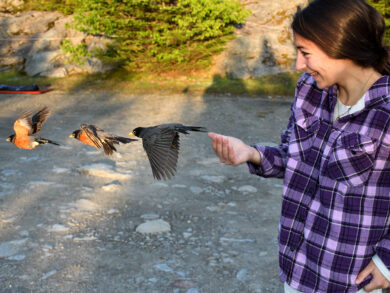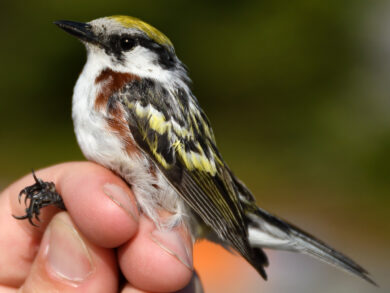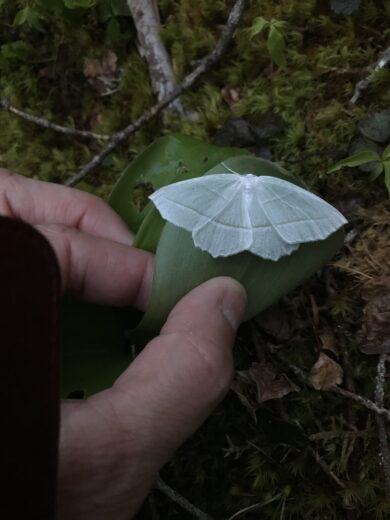As a graduate student in the early 2000s, I remember my Ornithology professor telling us about Bicknell’s Thrush research on Mansfield. It sounded like a glamorous location to study some pretty spectacular birds. On my third visit to Mansfield, I am still tickled to find myself right here on that same mountain, studying high-elevation birds twenty years later! I gotta say, it’s no wonder Chris Rimmer has been doing this for 32 years. I don’t think I could ever get tired of the sunrise over the ridgeline as we go on our first net runs.
This week Mansfield provided beautiful weather and cooperative birds for week four. A crew of myself, Chris Rimmer, Melory Brandao, Kevin Tolan, Nathaniel Sharp, and Chris Hansen trekked up the mountain for two days. We were joined by new VCE intern Natalie DeVito, who is joining us for the summer between her semesters at Brown University. Natalie was a natural at handling birds and provided essential assistance to keep the station organized and running smoothly.

VCE Intern Natalie DeVito, releasing a male American Robin. © Mike Sargent
With clear weather and calm winds, our nets were productive. We ended our first night with 19 birds, including a notable capture of a female Magnolia Warbler in a surprisingly dark male-like plumage. Her well-developed brood patch and egg in her abdomen confirmed she was a female, but the plumage was entirely misleading. In warblers, female birds can gradually develop male-like plumage as they age, so we suspect this female was very old. However, she was unbanded at the time of capture, so we’ll never know!
Day two was calm, but unfortunately, so were the Bicknell’s Thrush. We were surprised to hear more Swainson’s Thrush singing during the dawn chorus than Bicknell’s Thrush, who were surprisingly quiet. The steadfast dedication of our playbacks did bring in some birds, and we were able to recover two GPS backpacks and deploy Motus ‘nanotags’ on two other young second-year males. (More to come later on the Motus ‘nanotags’)
In the evening, Kevin, Nathaniel, and I had the opportunity to run Mansfield on our own, and we wished Chris well as he headed down the mountain. Although the capture rates were good, we were low on Bicknell’s Thrush, which we attributed to Chris taking his BITH mojo with him. However, we had a few interesting surprises in our nets. This included a Chestnut-sided warbler, a rare capture at this high elevation. We also caught two Sharp-shinned Hawks stealthily hunting the mountainside. Over the course of two evenings and two mornings, we ended up with 75 captures.
| Species | Individuals |
| American Robin | 1 female, 2 males |
| Black-and-white Warbler | 1 female |
| Bicknell’s Thrush | 2 females, 11 males |
| Black-throated Blue Warbler | 1 young male |
| Blackpoll Warbler | 4 females, 9 males |
| Black-throated Green Warbler | 1 male |
| Canada Warbler | 1 young male |
| Chestnut-sided Warbler | 1 young male |
| Golden-crowned Kinglet | 2 females |
| Magnolia Warbler | 1 female, 1 male |
| Myrtle Warbler | 14 males |
| Nashville Warbler | 1 male |
| Purple Finch | 1 male |
| Red-eyed Vireo | 1 unknown |
| Slate-colored Junco | 3 females, 1 male |
| Sharp-shinned Hawk | 2 males |
| Swainson’s Thrush | 4 males |
| Winter Wren | 1 female |
| White-throated Sparrow | 7 males |
| Yellow-bellied Flycatcher | 1 male, 1 unknown |

A young male Chestnut-sided Warbler was a spectacular sight for all.
Up on Mansfield, I’m joining the team to learn more about the day-to-day operations of this long-term project so that I can help keep this great dataset going. Melory, Natalie, and I are also adding a few additional pieces of data to help understand how species interactions on Mansfield may be affected by climate change. One new piece this year is that we are collecting very small samples of blood and fecal material to assess bird diets. Despite years of studying birds, we know very little about what birds eat and what insects might be important to birds while they nest. We are collecting samples from Bicknell’s Thrush, Swainson’s Thrush, White-throated Sparrow, Yellow-rumped Warbler, Magnolia Warbler, and Blackpoll Warbler to start piecing together the food web of Mount Mansfield.
In addition to collecting diet samples from our birds, we are also looking at insect availability. This week, Melory and Natalie worked long and hard to put in a series of pitfall traps, survey branches, and moth traps to monitor Mansfield insects. Fortunately for us, entomologists surveyed these same insects in the 1990s, so we can compare the diversity and abundance we observe to the data from 30 years ago. By linking this with VCE’s long-term bird data, we have an incredibly valuable long-term dataset on birds and insects in the same location.
Although our first night of moth trapping was slow, we did capture this beautiful Pale Beauty, a lovely white geometer moth more typically found at lower elevations. This species was only observed once on the Mansfield Summit between 1991-1995, yet we saw numerous individuals on this visit. Most likely, these moths will lay eggs on the birches and willows on the mountain, which will hatch into caterpillars to feed hungry Bicknell nestlings.

A pale beauty (Campaea perlata), on top of Mansfield
Next week we will check out traps to see what insects are available for birds to eat and enjoy another few days up on the mountain. Looking forward to seeing what we find!

Thanks for your work and this report, and esp that anecdote re academic/professional note being taken of the great Bicknell’s VCE project as long ago as two decades!!Veer Frost
Thank you for this great update on the Bicknell Thrush project on Mt. Mansfield. I have just filled out information inviting a lecture to our Lamoille Valley Olli Fall or Spring Lecture series which meets in Stowe, VT. Our participants are always interested in projects that especially impact our area as well as our future world. As senior citizens we are particularly interested in the world we leave our grandchildren.